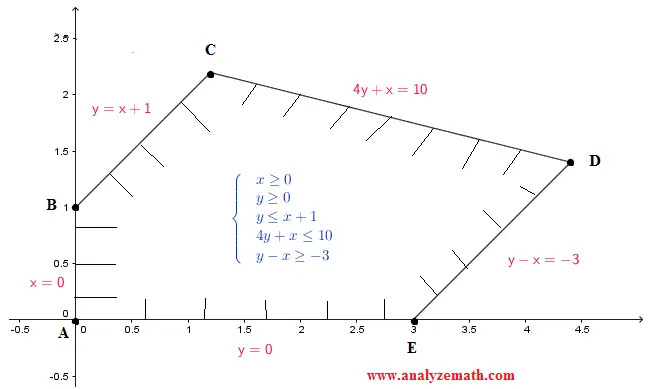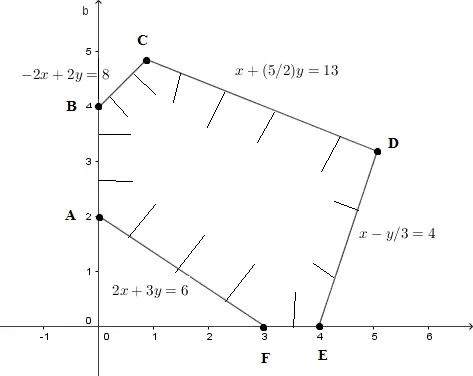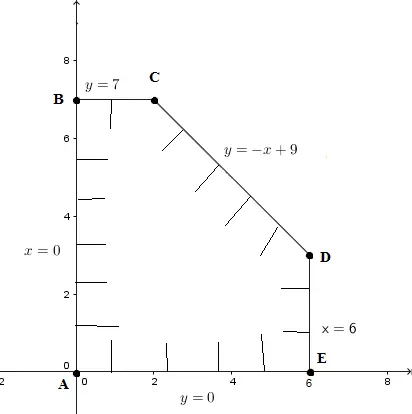What is linear programming?
A two-variable linear programming has a linear function f(x,y) in two variables, called objective function, along with systems of linear inequalities called constraints which defines the feasible solution set as defined in systems of inequalities with two variables.
Linear programming is one of the methods of optimization where there is a need to find values of some variables x, y so that function f of the variables x, y has a maximum or minimum value depending on the application to solve. Possible applications of linear programming may be found in engineering, agriculture, medicine, finance, economics, etc.
The solutions to a linear programming problem may be solved using the following theorems:
Theorem 1
The solution of a linear programming problem, it it exists, must occur at a vertex of the feasible set associated with the constraints of the problem. If the solution associated with the constraints and the objective function occur at two adjacent vertices, then all points on the line segment joining these two vertices are solutions.
Theorem 2
In a linear programming problem with a feasible set A and objective function f(x,y) = a x + b y, the following cases may occur
1) If A is bounded, then f(x,y) has both a maximum and a minimum at the vertices of A.
2) If x ≥ 0 and y ≥ 0 and if A in unbounded, and both a and b are positive, then f(x,y) has a minimum at one (or more) of the vertices of A.
Examples with detailed solutions and explanations are presented.
Example 1: Find maximum value
Find the values of x and y that make z(x , y) = 2 x + 4 y maximum subject to the conditions shown below and find the value of z at these values of x and y
\[
\begin{cases}
\ x \ge 0 \\
\ y \ge 0 \\
\ y \le x + 1 \\
\ 4y + x \le 10 \\
\ y - x \ge - 3 \\
\end{cases}
\]
Solution to Example 1:
The solution set of the system of inequalities given above and the vertices of the feasible set obtained has already been found in
Example 3 of "solving systems of inequalities in two variables". The solution set is shown in the figure below.
 .
.
The vertices were also found (in the same example) to be:
A(0 , 0), B(0 , 1), C(6/5 , 11/5), D(22/5 , 7/5), E( 3 , 0)
We now evaluate function z(x , y) = 2 x + 4 y at all 5 vertices of the feasible set.
-
at A: the x and y coordinates of A are x = 0 and y = 0.
Substitute x and y by 0 and 0 respectively in the linear function z = 2 x + 4 y to obtain z(A) = 2 (0) + 4 (0) = 0
- at B: the x and y coordinates of B are x = 0 and y = 1.
Substitute x and y by 0 and 1 respectively in the linear function z = 2 x + 4 y to obtain z(B) = 2 (0) + 4 (1) = 4
- at C: the x and y coordinates of C are x = 6/5 and y = 11/5.
Substitute x and y by 6/5 and 11/5 respectively in the linear function z = 2 x + 4 y to obtain z(B) = 2 (6/5) + 4 (11/5) = 11.2
- at D: the x and y coordinates of D are x = 22/5 and y = 7/5.
Substitute x and y by 22/5 and 7/5 respectively in the linear function z = 2 x + 4 y to obtain z(B) = 2 (22/5) + 4 (7/5) = 14.4
- at E: the x and y coordinates of D are x = 3 and y = 0.
Substitute x and y by 3 and 0 respectively in the linear function z = 2 x + 4 y to obtain z(B) = 2 (3) + 4 (0) = 6
The maximum value of z occur at vertex D with coordinates x = 22/5 and y = 7/5. Hence the solution of the given problem is Z has a maximum value at x = 22/5 and y = 7/5 and this value is 14.4
 .
.
 .
.